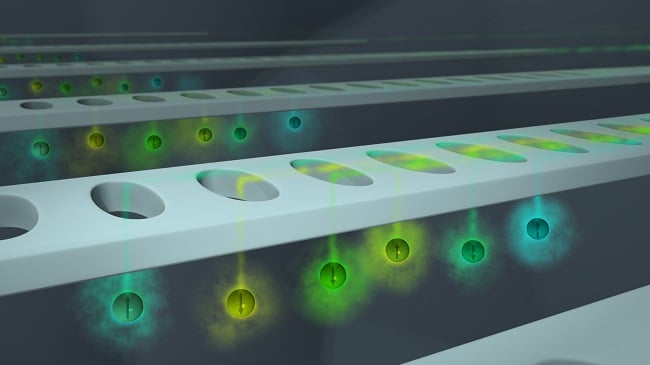Researchers from Princeton University have formulated a method to control and measure atoms that are indistinguishable when observed with an optical lens. The work allows the researchers to observe atomic interactions and quantum mechanical behavior. The research has implications for quantum networking and the study of the fundamental dynamics of strongly interacting quantum systems.
By studying the atoms and their interactions at what the researchers described as "tiny" distances, the researchers were able to look at and control spin, a quantum property and a form of momentum described as being either up or down, or both. When distances between two atoms are vanishingly small, in the realm of billionths of a meter, the spin of one atom influences the spin of its neighbor, and vice versa. As the spin of the atoms interact, they can become entangled.

Artist's rendering of a method of measuring and controlling quantum spins developed at Princeton University. Courtesy of Rachel Davidowitz.
The method successfully excited closely spaced erbium atoms in a crystal, using a finely tuned laser in a nm-scale optical circuit. The researchers then observed the atoms’ fluorescence; when the laser illuminated the atoms, it excited them just enough to emit a faint light at a specific frequency, yet delicately enough to preserve and read out the atoms’ spins. Those frequencies changed subtly according to the atoms' different states. "Up” had one frequency, “down” had another, and each individual atom had its own pair of frequencies.
The erbium atoms in the system sit inside an yttrium orthosilicate crystal, which has a layer of silicon patterned with photonic crystal cavities that amplified their fluorescence.
“The cavities are actually patterned in the device layer of a silicon-on-insulator wafer, and then transferred to the [yttrium orthosilicate crystal] using a stamping technique,” Jeff Thompson, assistant professor of electrical engineering at Princeton, told Photonics Media. “The whole experiment takes place in a 3He cryostat at a temperature of about 500 mK.”
Each atom responded to a slightly different frequency of laser light, allowing the researchers to resolve and control multiple atoms without relying on spatial information.
The device developed by the researchers has promise in studying those spin interactions, and has the potential to address hundreds of atoms at a time.
“If you have an ensemble of these qubits, they all emit light at very slightly different frequencies. And so by tuning the laser carefully to the frequency of one or the frequency of the other, we can address them, even though we have no ability to spatially resolve them,” Thompson said. “Each atom sees all of the light, but they only listen to the frequency that they’re tuned to.”
The light’s frequency is therefore a suitable proxy for spin. Moving the spin up and down provided a method to make calculations, akin to transistors that are either on or off in a classical computer.
To form the basis of a quantum processor, though, the scientists must develop the technology further.
“The strength of the interaction is related to the distance between the two spins,” said Songtao Chen, a postdoctoral researcher in Thompson’s lab and one of the paper’s two lead authors. “We want to make them close so we can have this mutual interaction, and use this interaction to create a quantum logic gate.”
Though the team is able to control and measure the spin state of its qubits regardless of how close they are, and use optical structures to produce accurate measurement, they aren’t yet able to arrange the qubits in order to form two-qubit gates. To do so, they’ll need a different material to host the erbium atoms.
“One of the major advantages of the way we have done this experiment is that it has nothing to do with what host the erbium sits in,” said Mouktik Raha, a sixth-year graduate student in electrical engineering and one of the paper's two lead authors. “As long as you can put erbium inside it and it doesn’t jitter around, you’re good to go.”
The research was published in Science (www.doi.org/10.1126/science.abc7821).